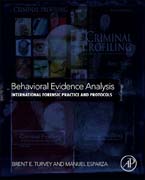
Behavioral Evidence Analysis: International Forensic Practice and Protocols
Turvey, Brent E.
Esparza, Manuel
The criminal profiling community can easily be split into two separate groups: those that have written criminal profiles and those that have not. It is an important distinction, because report writing is one the most important requirements of good scientific practice. The process of writing up findings helps to reveal flaws in an examiner's logic so that they can be amended or revisited; the final report memorializes findings and their underlying basis at a fixed point in time; and as a document a forensic report provides the best mechanism for transparency and peer review. The problem is that many criminal profilers haven't written criminal profilers, and still more prefer that this remain the case, often to conceal their lack of methodology or ability. The contributors to this volume have travelled the world for more than a decade to lecture on the subjects of crime scene analysis and criminal profiling. The result has been a steady stream of requests continued from educational institutions and government agencies alike to teach the application of criminal profiling theory. Everyone has read the books, everyone has attended the lecture; but few have experience with hands on practice and application. In other words, there is a growing number of serious professionals that want to know how to put theory into practice, and then learn what it means to put their findings into written form. Behavioral Evidence Analysis: International Forensic Practice and Protocols has been written as a companion text to Turvey's Criminal Profiling, now in its 4th edition. It is meant to provide the legion of instructors that are teaching criminal profiling as a subject with real world examples of case reports. It is also meant to serve as a desk reference for professionals that are writing crime scene analysis and criminal profiling reports, to enable sampling of structure, terminology, and references. One of a kind desk reference containing actual criminal profiles for student and examiner referenceContributions prepared by an international group of board certified criminal profilersReports are prepared in relation to both investigative and forensic contextsDemonstrates the utility of criminal profiling in both teaching and a caseworkCompliant with practice standards and ethical guidelines published by the International Association of Forensic Criminologists, the Academy of Behavioral Profiling, and the Global Forensic Alliance INDICE: Chapter 1: Applied Criminal Profiling: Investigative and Forensic RelevanceChapter 2: Statistical Methods of Criminal ProfilingChapter 3: Criminal Profiling: Frauds and FailuresChapter 4: Behavioral Evidence Analysis: Investigative and Forensic ApplicationsChapter 5: The IAFC - Criminal Profiler Professional Certification Act of 2013Chapter 6: The U.S.: Threshold Assessments as a Teaching ToolChapter 7: Mexico: Criminal Profiling and Forensic InvestigatorsChapter 8: Portugal: Applications of BEA and Forensic CriminologyChapter 9: South Korea: Criminal Profiling ApplicationsChapter 10: Threshold AssessmentsChapter 11: Equivocal Death AnalysisChapter 12: Investigating Staged Crime
- ISBN: 978-0-12-800607-8
- Editorial: Academic Press
- Encuadernacion: Cartoné
- Páginas: 382
- Fecha Publicación: 02/07/2016
- Nº Volúmenes: 1
- Idioma: Inglés
